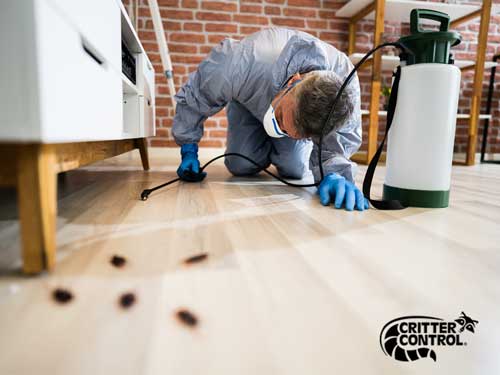Bed Bug Treatment Breakdown: Comparing Chemical Vs. Non-Chemical Solutions
In the realm of insect control, specifically when handling the consistent problem of bed pests, the selection in between chemical and non-chemical treatment solutions can be an essential one. Both approaches offer unique advantages and drawbacks, influencing factors such as performance, security considerations, and total expense. By checking out the nuanced information of each method, a clearer understanding of which course to go after in attending to a bed insect invasion can be acquired.
Performance of Chemical Therapies
Chemical therapies for bed bug problems have actually been extensively recognized for their rapid and potent efficiency in eradicating these pests. When taking into consideration the efficiency of chemical treatments, it is essential to understand that they can give a comprehensive and fast option to a bed pest issue. Professional pest control operators commonly rely upon pesticides to target bed bugs at different phases of their life process, including eggs, grownups, and fairies. These chemicals generally work by interrupting the bed pests' nerves, causing paralysis and eventual fatality.
Additionally, chemical therapies have the benefit of supplying recurring results, suggesting that they can remain to get rid of bed insects also after the preliminary application. This recurring activity is especially valuable in combating any kind of possible re-infestations. Additionally, the rapid action of chemical therapies can bring relief to people encountering extreme bed bug invasions, enabling them to gain back control of their living spaces swiftly.
Security Worry About Chemical Solutions
One essential facet that needs careful factor to consider when making use of chemical services for bed bug therapy is guaranteeing the safety of residents and the setting. Exposure to particular chemicals utilized in bed insect treatments can lead to respiratory problems, skin irritation, or various other damaging responses, particularly in people with pre-existing conditions or level of sensitivities.
Additionally, the environmental impact of chemical options is another considerable factor to consider. Some chemicals made use of in bed bug therapies may be unsafe to helpful insects, wildlife, and ecosystems if they seep into the soil or water supply. It is important to utilize chemical therapies judiciously, adhering to security standards, and thinking about much less harmful options to minimize these threats and make sure the secure and effective management of bed pest problems.
Advantages of Non-Chemical Approaches
Considering the prospective safety and security issues and ecological impact connected with chemical services for bed pest treatment, exploring non-chemical strategies presents an appealing option with a number of unique advantages. Non-chemical approaches supply a safer option for households, especially those with youngsters, individuals, or pets conscious rough chemicals. These strategies eliminate the risks of direct exposure to poisonous materials, minimizing the possibility for damaging health and wellness impacts. Moreover, non-chemical treatments are eco-friendly, as they do not add to air or water contamination, making them a sustainable choice for pest control.
Additionally, non-chemical remedies can be efficient in targeting bed bugs, including hard-to-reach locations where chemical treatments might not permeate. Approaches such as heat therapy, vacuuming, heavy steam cleansing, and bed mattress encasements give thorough obliteration without making use of harmful chemicals. Furthermore, non-chemical approaches can be much less turbulent, requiring very little preparation and enabling quicker reentry into dealt with locations. Generally, opting for non-chemical bed pest treatment techniques not just focuses on security and environmental security yet additionally guarantees detailed and reliable pest control.
Limitations of Non-Chemical Treatments

Furthermore, non-chemical therapies typically need multiple applications to achieve successful obliteration. This can be time-consuming and might not always ensure total removal of all bed insects and their eggs, particularly in hard-to-reach or covert areas.
Furthermore, the success of non-chemical treatments greatly depends on appropriate execution and thoroughness, which can be testing for individuals without expert proficiency. Insufficient application of non-chemical approaches might result in incomplete elimination, resulting in consistent invasions and the requirement for extra therapies.
For that reason, while non-chemical treatments have their advantages, it is important to recognize these limitations and consider them when identifying the most efficient strategy for managing bed bug infestations.
Expense Contrast: Chemical Vs. Non-Chemical Options
Given the restrictions related to non-chemical therapies, a crucial facet to examine in the context of bed insect administration is the cost comparison between chemical and non-chemical options. Chemical therapies typically entail the application of insecticides by experts, which can range from $250 to $900 per area, depending upon the intensity of the problem and the dimension of the location to be dealt with. On the other hand, non-chemical therapies like warmth treatment or heavy steam can be much more pricey, with prices varying from $1,000 to $6,000 for an entire home. While the initial price of chemical treatments may seem lower, several therapies might be needed to completely eliminate the problem, possibly increasing the total price. On the other hand, non-chemical alternatives may give a much more sustainable and eco-friendly remedy, although they can be cost-prohibitive for some individuals. Ultimately, when thinking about the price of bed insect therapy choices, it is necessary to evaluate the ahead of time expenses versus the efficiency and long-lasting sustainability of the chosen approach.
Final Thought

Taking into consideration the prospective safety and security issues and ecological influence associated with chemical remedies for bed insect therapy, exploring non-chemical methods provides an encouraging option with numerous distinct advantages.Provided the restrictions connected with non-chemical treatments, a crucial facet to my link assess in the context of bed bug monitoring is the price contrast in between chemical and non-chemical options. In contrast, non-chemical therapies like warm treatment or heavy steam can be a lot more expensive, with costs varying from $1,000 to $6,000 for a whole home. While the preliminary expense of chemical treatments might appear reduced, numerous therapies may be needed to completely get rid of the problem, possibly increasing the general expense.In verdict, when contrasting chemical and non-chemical bed pest therapy alternatives, it is important to take into consideration effectiveness, safety, benefits, limitations, and find more cost.